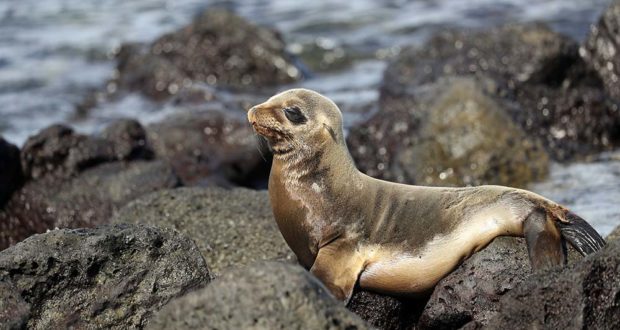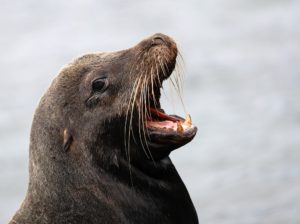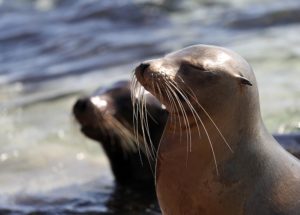By early morning they are already laying end to end on the beaches. Every once in a while, they roll over in the sand and shout to passers-by. When the sun gets too hot, they amble down toward the water to cool off. The younger ones splash about in the waves all day long. And during the day it’s not uncommon to see one lounging along the boardwalk or stretched out on a bench near the shops.
At the tip of San Cristobal there’s a beach called Loberia, literally “where the sea lions are”. And they were there, once. But some time ago they moved en masse to the beaches near the city – Playa del Oro, Playa Mann and Punta Carola. Today if there’s a sea lion at Loberia, it’s probably lost. The locals have all sorts of explanations for the move: the noise from the airport, changes in sea currents, and even the fickle choice of a few sea lion trendsetters who brought all the hangers on with them. Nobody really knows.
Sea lions don’t mind sharing their beaches with the other tourists, unless they get too close. People are under a restraining order of sorts, requiring them to keep at least two meters away, but in practice the sea lions will come up and plop down right next to them. On a beach up the coast I’d settled under the only tree that was throwing any shade when one came lumbering up the beach, barking all the way as if to say, “You’re in my spot.” I stood my ground, and it eventually backed off. But the first time I walked down to the water, it quickly slipped in behind me. When I was gathering data later, counting the sea lions on the beaches, I was repeatedly accosted by the same one, bearing the numbered tag “007”. If I got too close, it not only barked and charged me but chased me some distance down the beach.The Galapagos sea lion (Zalophus wollebacki), once thought to be a subspecies of its California cousin that inhabits Pier 39 in San Francisco, is now considered a separate, endemic species. Their population fluctuates, but reaches up to 50,000 throughout the islands.
Most of the sea lions laying on the beaches were females or juveniles, with a dominant bull somewhere nearby. The bull is more than twice the size of the females and has a prominent sagittal crest. It is aggressively territorial, throwing its considerable weight around or barking at another male fleeing into the sea as if to say, “Yea, I thought so.”
(One of the difficulties for a researcher dealing with other large mammals is resisting the temptation to impose human thoughts and feelings on them. But here, I’ll forgive my transgressions.)
Females are not only smaller but sleeker than fully grown males. Typically, about a half dozen of them on each beach were nursing juveniles, which they sometimes do for more than a year after birth. When they are pups, sea lions resemble small dogs with dopey black circles around their eyes.Young males tend to gather in packs with other bachelors where they are unlikely to provoke the interest of the dominant bull. One group I saw was hunkered down under an upturned boat hull.
Sea lions are fairly awkward on land, twisting and shimmying up the beach, often plopping down for a rest in the sand before laboring on. Unlike seals, they are able to stand up on their fins when they walk. But sea lions are truly in their element in the water, their sleek bodies and powerful fins propelling them acrobatically through the heart of a school of helpless sardines or in circles around a bewildered snorkeler. One of my colleagues had her fins pulled off by a sea lion, revealing her to be just a poser.
Sea lions carry on most of their serious business at sea, both feeding and mating. Often you’ll see one laying on its back in the shallows, all four fins sticking up in the air. The behavior, known as “sailing”, helps warm them in the chilly Galapagos waters. The blood vessels in their fins are close to the surface and readily absorb heat. On the beach, where they need a good sunscreen, they often roll in the sand until they are a powdery white from end to end.


